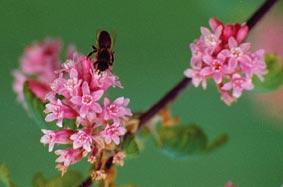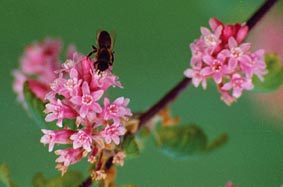The birds and the bees

They really aren't the best of friends, as Éanna Ní Lamhna explains
It's a great summer for bees, as anyone who has been outdoors over the last few weeks will have noticed. Bees are the goody-goodies of the insect world. They are the only insects that actively seek out pollen and collect it in special pollen baskets on their legs to bring home to feed their baby sisters. Grown-up honey bees do not eat pollen, preferring honey, which is made in the hive from nectar collected from flowers. So the busy bee spends the first three weeks of its adult life collecting pollen for the babies, the second three weeks collecting nectar for honey production and then dies of exhaustion. Some existence!
But honey bees (pictured below) are by no means the only bee you will see in your garden this summer. Bumblebees are very obvious too. We have up to 12 species of native bumblebee and they are distinguishable by their colours. At the moment, the large bombus lucorum, with a white tail, and the smaller bombus agrorum, with the orange shoulders, are investigating every new flower that opens in my garden. Like honey bees, they are social bees, answerable to a queen whom they protect with their sting. They will lay down their lives if necessary in defence of the colony and the queen.
Birds know this very well and steer well clear of them. One ill-advised meal of a bee with a sting teaches an incautious, inexperienced young bird never ever to eat anything with yellow and black stripes again. But there are in fact several species of solitary bee that are currently making their presence felt in the gardens of our more observant readers, which have no stings and indeed could be eaten by birds. These are miner bees and leaf-cutting bees. As these are solitary bees setting up their own nest and laying just a few eggs, they have no queen to mind and so have no stings. The miner bees each lay their eggs in a hole they have excavated in sandy soil. Each hole may be very near to the next – sort of a housing estate of bees – but each one is independent of the next. They probably don't even exchange idle chatter with each other as they fly in and out of the hole they have excavated, laying their eggs, provisioning the larva with food and then sealing off the mouth before departing.
Leaf-cutter bees make more of a drama. One lot I heard of recently took to cutting semi-circles out of the leaves of a rose bush and carrying the cut sections to the hollow handle of the barbeque where they rolled them into tubes, inserted them into the handle and laid eggs in them. They sealed off the whole thing when it was full – the owners of the barbeque were reduced to frying the sausages indoors from then on.
Irish birds don't go near miner or leaf-cutter bees either – reading wildlife articles in Village is not their strong point, so they generally decide to be safe rather than sorry.
